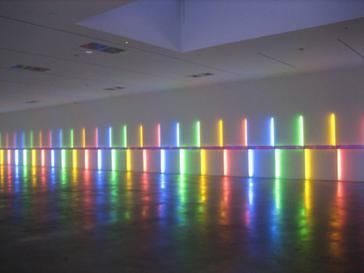 | ||
Light art is an applied arts form in which light is the main medium of expression. It is an art form in which either a sculpture produces light, or light is used to create a "sculpture" through the manipulation of light, colours, and shadows. These sculptures can be temporary or permanent, and can exist in two distinctive spaces: indoor galleries, such as museum exhibits, or outdoors at events like festivals. Light art can be an interaction of light with in an architectural space. Light artist are those that devote all their creative experimentation to light art, some artist experiment with light and neon signage and use light in their practice but would be artist using light.
Contents
History
Modern light art has its beginning in the advent of electricity at the turn of the century.
Modernism, Constructivism and the Bauhaus (1920–1935)
Light has been used for architectural effect throughout human history. However, the modern concept of light art emerged with the development of artificial electric incandescent light sources and experimentation by modern artists of the Constructivist and Bauhaus movements. "Prounenraum (Proun room) (1923), by El Lissitzky, is considered by many art historians to be the first time an artist incorporated architectural lighting elements as a component integral to his work." The first object-based light sculpture was the Light-Space Modulator (1922-1930), by László Moholy-Nagy. Experimentation and innovations in theatrical light have often influenced other areas of light use such as light art. The development of Modernism and the electric light go hand-in-hand; the idea of the modern city with high-rises and electric light epitomizes this development.
All visual art uses light in some form, but in modern photography and motion pictures, use of light is especially important. However, with the invention of electrical artificial light, possibilities expanded and many artists began using light as the main form of expression, rather than solely as a vehicle for other forms of art. Constructivist Naum Gabo experimented with the transparent materiality light reflects on an object; his Linear Construction No. 1 (1943) provides an example of this. Marcel Duchamp's Hat Rack (1916 and 1964), hangs from the ceiling and casts a shadow against the wall.
Art critic Hilarie M. Sheets explains that "the interplay of dark and light has been a theme running from Greek and Roman sculpture to Renaissance painting to experimental film. But as technology advanced from the glow of the electric light bulb to the computer monitor, artists have been experimenting with actual light as material and subject."
Projection mapping
Closely associated art forms are projectors, 3-D map projection, multi-media, video art, and photography where light technology projects images rather than using light as the medium. Large light festivals and events have helped to develop the use of light on large canvases such as architectural facades, building projections, the flood lighting of buildings with colour, and interactive media facades. These forms of light art have their antecedents in new media-based, video art and photography which are sometimes classified as light art since light and movement are important to the work.
Digital graffiti
Also included in the light art genre is the so-called light graffiti including projection onto buildings, arrangement of lighted windows in buildings, and painting with hand-held lights onto film using time exposure.
Museums
Many modern art museums include light sculptures and installations in their permanent and temporary collections. The Centre for International Light Art in Unna, Germany is currently the world's only museum dedicated exclusively to the collection and presentation of light art.
The Light Art Museum in Eindhoven, Netherlands, another museum dedicated to the display of light art, closed on December 5, 2010 due to insufficient funding.
Many well-known art museums, such as the San Francisco Museum of Modern Art and the Museum of Modern Art in New York, often have temporary light art exhibits and installations in their galleries.
Light festivals
Light festivals and the smart city LED revolution was driven by outdoor urban light sculpture with low energy LED luminaires. Light artists were able to create new exhibition spaces collectively in the form of light art festivals. These festivals have continued to grow internationally and help to highlight ecological change. This LED low energy movement dates back to the 2009 by the Vivid Smart Light Festival in Sydney. In Singapore, the i Light Marina Bay festival—Asia's only sustainable light festival—was first hosted in 2010. There are many light art festivals, especially in Europe, including the Signal Festival in Prague and the Ghent Light Festival. Light festivals and LEDS have redefined light art as an art genre.
(Singapore)
Light Art Awards
The International Light Art Award, presented by the Centre for International Light Art Unna and the RWE Foundation, is given to up-and-coming artists who will contribute "to the development of light art in an innovative and creative way" and has been in existence since 2015.
The award is meant to encourage artists to explore light art, despite the difficulties the relatively new style faces, including the financial and technical requirements needed for a light art exhibit. The foundations behind the ILAA also wish to put emphasis on sustainability and new technologies within the medium of light expression.
The Australian and New Zealand Engineering Illumination Society ANZIES began giving an annual award to light artists at the Vivid Light Festival in 2010. Vivid Light festival grants help support local and international light artists in the pursuit of their medium. 2015 The DARC awards, supported by Mondo Arc Magazine, began selecting winners for their light art awards. The International Association of Lighting Design the IALD, a North American-based organization, also gives out an annual award for light art.
